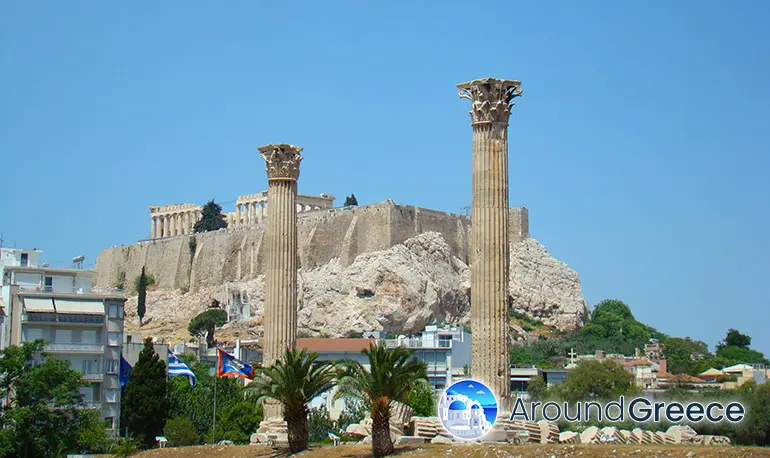The Biggest Temple in Ancient Greece
In its day, the Temple of Olympian Zeus was the largest temple in Greece, dwarfing even the Parthenon on the Acropolis in Athens, and the Temple of Apollo at Delphi. Today, little remains of this mighty temple, apart from the 15 original Corinthian columns that remain standing.

This stunning site is located approximately 500 meters south-east of the Acropolis and 700 meters south of Syntagma Sqaure in the centre of Athens. The size of the temple in its prime was a dominating 107 by 41 meter structure, and was modeled on the Temple of Hera on the island of Samos.
Work began on this temple in the 6th century B.C. According to estimates of archaeologists, foundations on the site were laid during the era of the Peisistratid tyranny. However, after Hippias, son of Pisistratus, was overthrown in 510BC, work was abandoned. Left unfinished for many years during the time of the birth of Democracy in Greece, due to several reasons, including the fact that the Greeks of this time believed constructing a temple on such a huge scale was over the top, and not necessary.
Work was resumed in 174 BC, during the Macedonian domination of Greece. King Antiochus IV of Syria was the man who appointed the Roman architect Cossutius, to design and build the largest temple in the known world. However, after the death of Cossutius in 164BC, work was again put on hold.
After the Roman rule of Greek cities in 86 BC, it is said that the General Sulla took two of the columns from the unfinished site to Rome, to add to the Temple of Jupiter, on the Capitoline Hill. In effect, these columns acted as an influence to the Corinthian style in Rome during those years.

It was not until 131 or 132 AD that the temple was finally completed, under the direction of Emperor Hadrian. The marble used for the construction of the temple was brought from Mount Penteli. It constituted of 104 Corinthian columns, each standing 17 meters in height. 48 of these columns stood in triple rows under the pediments, and 56 were places in double rows at the sides of the temple.
During the Panhellenic festival in 132 AD, Hadrian dedicated the temple to Olympian Zeus, the King of the Gods. Inside the temple, a gold and ivory statue depicting Zeus was placed, alongside another statue of Hadrian himself. However, nothing of these statues, or even anything from the interior of the temple remains.
The fate of this mighty temple is unclear. It is said that when Cyriacus of Ancona visited Athens in 1436, there were only 21 columns left. The most logical answer is that the temple must have been brought crashing to earth by an earthquake during the Medieval period, with the ruins taken away and reused for building materials.
In 1852 during a very strong gale, a 16th column was brought down, and can be seen today, exactly as it fell, with the drums of the column spread over the ground.

During the course of archaeological excavations carried out, many interesting finds were discovered. In 1889-1896, the temple was excavated by Francis Penrose, (of the British School in Athens.) In 1922, it was the turn of German archaeologist Gabriel Welter, followed by Greek archaeologists in the 1960s.
These excavations led to the discovery of the foundations of houses and other smaller buildings from the classical period, the remains of the Themistoclesian city wall and a complex of Roman baths. These baths have actually been preserved with the marble mosaics.
Walking around this ancient site, is an inspiring experience, and seeing the remaining standing columns gives you an impressive of the scale of this temple, and the work that went into making it the largest temple anywhere in Greece.
Map of the Temple of Olympian Zeus
Below you will find a map which shows the location of the Temple of Olympian Zeus in Athens. Click on the map image below to load the Google map.
Visitor Information
Opening Hours:
Summer - Daily from 08:00 - 19:30 (Monday from 11:00)
Winter - Daily from 08:30 - 15:00
Entrance Fee / Prices:
4 Euros | Reduced 2 Euros | Is also part of the Multi Ticket for Archaeological Sites in Athens
Location:
The Temple of Olympian Zeus is located next door to Zappeion and the National Gardens, and the entrance is found on the Vasilissis Olgas Avenue.
Top Sights in Athens
- Ancient Agora
- Areopagus (Hill of Ares)
- Athenian Trilogy
- Filopappou Hill
- First Cemetery of Athens
- Hadrian's Arch
- Hadrian's Library
- Hill of the Nymphs
- Kerameikos Cemetery
- Lycabettus Hill
- Lysicrates Monument
- National Gardens
- Panathenaic Stadium
- Pnyx
- Roman Agora
- Syntagma Square
- Temple of Olympian Zeus
- Tower of the Winds
- Zappeion
